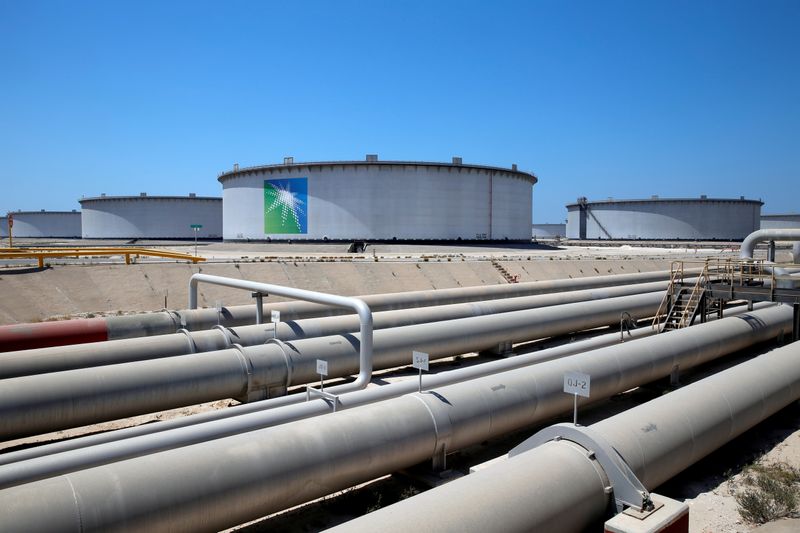
FILE PHOTO: General view of Aramco tanks and oil pipe at Saudi Aramco’s Ras Tanura oil refinery and oil terminal in Saudi Arabia May 21, 2018. REUTERS/Ahmed Jadallah/File Photo
September 6, 2021
By Julia Payne
LONDON (Reuters) – Oil prices fell on Monday, extending losses after the world’s top exporter Saudi Arabia cut crude contract prices for Asia over the weekend, reflecting well-supplied global markets and concerns over the demand outlook.
Brent crude futures for November fell 28 cents, or 0.39%, to $72.33 per barrel by 1229 GMT.
U.S. West Texas Intermediate crude for October was at $69.04 a barrel, down 25 cents, or 0.36%. Both contracts were down more than $1 in earlier trade.
State oil group Saudi Aramco notified customers in a statement on Sunday that it will cut October official selling prices (OSPs) for all crude grades sold to Asia, its biggest buying region, by at least $1 a barrel.
The price cuts were larger than expected, based on a Reuters poll of Asian refiners.
“The cut in Saudi OSPs to Asia provided a brief downside pressure this morning, which the market is recovering from,” Tamas Varga at PVM Oil Associates said.
“The monthly EIA report (U.S. government data) due out Wednesday will be eagerly watched and in case demand estimates for the balance of this year and for 2022 remain solid the market could easily edge towards the high seen in July.”
Global oil supplies are increasing as the Organization of the Petroleum Exporting Countries and their allies, a grouping known as OPEC+, is raising output by 400,000 barrels per day each month between August and December.
“Given that OPEC+ is continuing its plan to raise production monthly, despite weak data from China and the U.S. raising slowdown fears, and Saudi Arabia looking for market share in the region, oil is likely to remain under pressure,” said Jeffrey Halley, a senior market analyst for Asia Pacific at brokerage OANDA.
The decline in crude futures added to falls on Friday after a weaker than expected U.S. jobs report indicated a patchy economic recovery that could mean slower fuel demand during a resurgent pandemic.
Losses were capped by concerns that U.S. supply would remain limited in the wake of Hurricane Ida.
The U.S. government is releasing crude from strategic petroleum reserves as production in the U.S. Gulf Coast struggled to recover.
Some 1.7 million barrels of oil and 1.99 billion cubic feet of natural gas output remained offline, government data released on Friday showed, while power shortages are preventing some refineries from resuming operations.
The hurricane also led U.S. energy firms last week to cut the number of oil and natural gas rigs operating for the first time in five weeks, data from Baker Hughes showed on Friday. The oil rig count fell the most since June 2020.
(Reporting by Florence Tan and Julia Payne; editing by Simon Cameron-Moore, Jason Neely, Louise Heavens and Jane Merriman)

